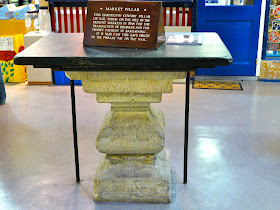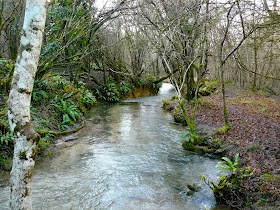 The Pulteney Bridge
The Pulteney Bridge
We met up with friends for a city walk around Bath, following the City Trail described in the excellent leaflet available from the tourist office.
The walk starts there and our first thought was to look inside the nearby Abbey church, but unfortunately for us a service was underway - fair enough on a Sunday morning.

Then we made an immediate detour into the Roman Baths Museum. This was really excellent, but threatened to derail the whole undertaking so we had to limit our time there. The picture shows the original bath, although the columns, viewing platform and statues of Roman emperors were all added in Victorian times. The join between old and new is fairly obvious.

We were very struck by the original hot spring, where you can still see the steam rising and water apparently bubbling up (the helpful audio guide revealed that in fact this is bubbles of gas).

The museum was very well done and gave a very clear sense of what the original bath and temple complex must have been like. The big insight was that in Roman times the temple was much the more important.
The route then heads west and passes the new
Thermae Bath Spa, the only natural thermal spa in Britain, where you can take the waters in hygienic conditions and also swim in the roof swimming pool. You then head up
Westgate and pass the Theatre Royal. The current entrance is unprepossessing, but by turning left into
Beauford Square you can see the beautiful original facade.

The opposite side of the street has a fine row of what were originally artisans' houses. The route continues up the hill and across John Wood the
elder's fine Queen Square, with the "palace" - seven private houses built as if they were a single entity with a central pediment. We saw many similar ones in St
Petersburg earlier in the year.
The route then turns into Gay Street, past the celebrated sedan chair houses (they are actually stands where the chairmen would rest their chairs - "houses" caused us some confusion). Then it turns right up steps to the Gravel Walk, off which is the small Georgian Garden. We found this a bit disappointing - we have a better box hedge in ours! One very interesting feature of the rear of the houses which back onto the Walk was how irregular they are: apparently the architects designed uniform fronts, but left the builders to complete the backs according to each customer's wishes.

At the end of the Gravel Walk you suddenly emerge into the vast lawn in front of John Wood the
younger's Royal Terrace. A wonderful vista.

A short walk along Brock St brings you to The Circus, designed by John Wood the elder, but completed by his son. This was Britain's first circular street. The continuous frieze at first floor level depicts 513 different motifs, thought to be masonic or mystical symbols.

By now it was time for lunch, cunningly planned to be on the route at the Moon and Sixpence, in
Milsom Place, just off
Milsom Street. Somewhat later, suitably restored we continued on our way in the gathering gloom. The route turns into the unusually named Quiet St and then into Queen St, off which stands a beautiful house with two curved pediments. It was the home of General Wolfe - he of Quebec fame.

A few more turns bring you to the Corridor, which dates from 1825 - a very early example in England of the newly fashionable shopping arcade (the first, Burlington Arcade , dates from only 1820). The leaflet drew our attention to the balcony where musicians would have played. So music in shopping precincts is not the awful American idea I had supposed!

Then across the road and into the market next to the Guildhall, where you can see the "nail" which gave rise to the phrase, pay on the nail.

We are now at the river and a quick detour to the right enables you to look back and down to see the
Eastgate, the only remaining medieval gateway to the city.

Next up is the lovely
Pulteney Bridge, designed by Robert Adam and completed in 1773. When you are on it looks just like a normal shopping street - because it is flat of course.

Along to Laura Place where you can see a hexagonal Victorian postbox.

At this point, we resisted the temptation to go on down the wide Great
Pulteney Street and instead returned over the bridge and made our way to the Abbey. The site previously housed a Saxon monastery church and a Norman cathedral, and the present abbey church was founded in 1499. Only 40 years later it was suppressed as part of
Henry VIII's dissolution of the monasteries and largely destroyed. Happily is was re-roofed and repaired in 1611. There was also a Victorian restoration and bomb damage during the second world war. Further restoration and cleaning took place in the 1990s. What you see today is a remarkably harmonious and unified building with a high nave with large windows and magnificent fan vaulting in both the nave and the aisles.

Distance: about 2.5 miles.
Rating: four and a half stars. The walk provides a very thorough encounter with the city and there are so many fantastic sights. But am I rating the walk or the city? How can they be separated?




























